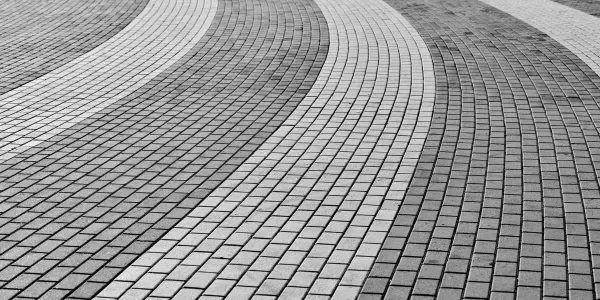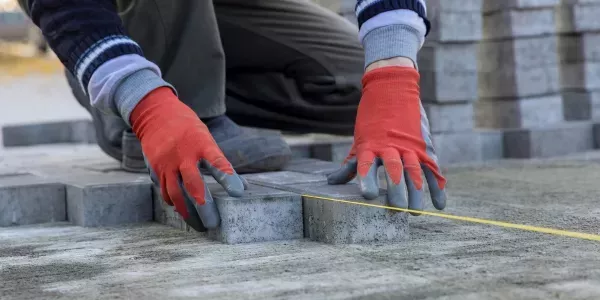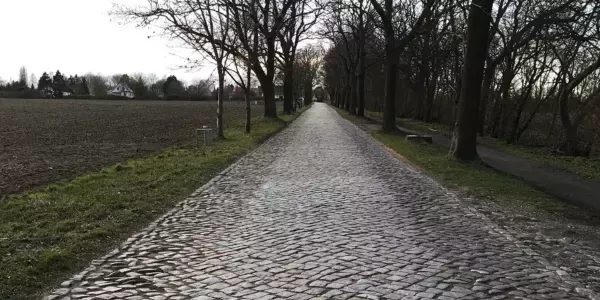Choosing a paver for your driveway will depend on your needs and tastes. When making such a decision you need to consider the characteristics you are looking for. There are permeable materials, there are eco-friendly materials, among others. You’ll also want to look into the durability of the paver and how to properly maintain it.
There are natural quarried stones such as cobblestone pavers, and some man made pavers like brick and concrete are in the market. Each one has its pros and cons, and learning about them will help you decide which one is the most suitable for you.
In this blog we will talk about these driveway pavers, how much they cost and the best way of laying them.
What are pavers?
Pavers, or paving stones, are usually natural stones or man made blocks with the purpose of creating a surface for roads, driveways, walkways, patios, and courtyards. They are functional and at same time bring elegance and personality to your front yard.
Brick pavers

Brick pavers are made of clay and have been used for a long time. This type of paver is undoubtedly one of the most beautiful. But is this one the right one for you?
| Pros | Cons |
| Recyclable | Higher price |
| Easy to Repair | Requires periodic sealing |
| Durable Material | More difficult to install |
| Attractive appearance | Fewer design options |
| Increases home’s value | Not indicated in regions where it snows |
A brick driveway costs around $10 to $25 per square foot and though they tend to last generations, they require repairs over time. Also, though brick pavers offer fewer design options, they can be arranged in different patterns. You can find brown, red, and clay-colored brick pavers.
How to install brick pavers
Plan and Design
Decide where you are going to lay the pavers, and what their pattern will be. Then, measure the area to calculate the number of pavers needed.
Prepare the Base
After deciding where you will put in the driveway, it’s time to excavate. Excavate the area to a depth of about 12 inches. After that, you need to lay a sub-base of crushed stone in layers of 8 to 12 inches, compacting each layer.
Sand Layer
Make sure your base is well compacted. After that start spreading a layer of sand over the compacted base to a depth of about 1-2 inches.
Laying Pavers
Start by laying the pavers from one corner or edge and continue along the edges until you have a straight row. Continue until the entire area is complete. Try to keep them tight against each other. Use a pattern to maintain straight lines.
Cutting Pavers
Cut pavers as needed to fit the edges using a masonry saw or chisel and hammer.
Level With a Plate Compactor or Roller
After all pavers are laid, spread fine sand over them and use a plate compactor or a roller to pass over the entire driveway. The machine’s vibrations and weight will pack the pavers firmly and lock them in place. The machine will also flatten and level the brick surface.
Sanding
Settle the sand into the joints until they are totally filled.
Finishing
Sweep off excess sand and check for any uneven pavers to adjust. Sometimes it's necessary to re-sand and compact more than once.
Sealing (Optional)
Apply a sealant to protect the pavers from stains and weathering.
Concrete pavers

Concrete pavers are blocks made of cement, aggregate, water, color pigments, and some chemicals. Is not a surprise that this is one of the most common pavers for driveways, since they have long durability, weather resistance and you can find a variety of designs and styles.
It might be more expensive than other materials like asphalt, for example, but its longevity and low maintenance make it worth the investment.
| Pros | Cons |
| Durability and Strength | Higher Cost |
| Low Maintenance | Installation Requirements |
| Permeable Options | Weed Growth and Shifting |
| Weather Resistance | Color Fading |
To install concrete pavers, a professional can charge you between $25 to $45 per square foot, but the pavers themselves may cost $5 to $20 per square foot, depending on the quality, size and style.
While concrete pavers offer aesthetic flexibility, durability, and ease of repair, they also come with considerations like higher initial costs, installation complexity, and potential maintenance issues like weed growth and staining. To decide if it is a right choice for you, weigh the pros and cons with your needs and expectations over the project.
Installing Concrete Pavers

Test the soil and excavate
Test the soil to see how well it absorbs the water. You can call for an underground utilities company to check it. After that, mark the area and/or remove the old pavement, and excavate to a minimum depth of 15 inches.
Stone layers
Cover the excavation with a 6-inch layer of ¾- to 2-inch crushed stone or gravel as the base. Compact it in layers using a plate compactor. Ensure the base is level and uniformly compacted.
Edge restraints
Place edge restraints (concrete or hard-plastic edging) around the perimeter of the area to maintain the shape and prevent pavers from shifting.
Place the layers
Set the pavers starting from the lowest corner, making sure they are tight to the edges and one another. If they are permeable pavers, the nibs on the sides of them create the drainage gaps. Use a masonry saw or a chisel to cut pavers as needed to fit the edges or to place around obstacles.
Sweep Sand into Joints
After all the pavers are laid, sweep fine sand over the surface to fill the joints.
Compact the Pavers
Go over the surface with a plate compactor to help the sand settle into the joints and secure the pavers.
Finishing touches
Sweep the surface clean and if necessary compact a few times to fully stabilize the pavers.
Cobblestone

Cobblestone is a natural stone usually made from various natural materials, including granite, basalt, limestone, and sandstone. Their round shape is usually the result of being worn smooth by the movement of water over an extended period of time, which is a natural process. Using cobblestone brings a unique, timeless charm reminiscent of historic streets, to your driveway.
| Pros | Cons |
| Durability | Higher price |
| Environmental friendliness | Installation complexity |
| Weather resistance | Uneven surface |
| Increased property value | Maintenance and comfort |
The cost of cobblestone is somewhere around $25 per linear foot. Besides the price being kind high if compared to others options, cobblestones prevent the driveway from flooding and its durability is incredible.
They don’t stain or are affected by weather, even less they will crack or split. But, of course, they have their downsides. While durable, cobblestones may require regular maintenance to keep weeds and moss at bay, and the uneven surface can be difficult for walking, particularly for those with mobility issues. They can make shoveling snow more challenging.
Installing Cobblestone
Design and Planning
Decide on the pattern and type of cobblestones. It's important to consider the driveway's size, slope, and drainage needs.
Preparation of the Base
Excavate the area to a suitable depth (usually around 8-10 inches) and lay a sub-base layer of crushed stone or gravel for drainage. This layer should be compacted firmly.
Edge Restraints
Install edge restraints to define the driveway's boundaries and prevent the stones from shifting.
Laying the Cobblestones
Lay the cobblestones on a sand or mortar bed. The stones should be placed closely together in the chosen pattern.
Filling the Joints
Fill the joints between the cobblestones with sand or mortar to stabilize the driveway and prevent weed growth.
Compaction and Finishing
Once all stones are laid, the surface should be compacted with a plate compactor. Finally, clean the surface and fill any gaps in the joints as needed.
People also ask
Which Driveway Surface is the Best?
It will depend on your tastes and needs, but concrete pavers are on the top list due their durability, permeability (optional) and low maintenance.
Do I Need Planning Permission for a New Driveway?
It will depend on local regulations and the type of material you plan to use. Generally, if your new driveway uses non-permeable materials (like concrete, asphalt, or some block paving) and does not have adequate drainage, you might need planning permission.
What’s the Eco-Friendliest Type of Driveway?
Eco-friendly driveways are those that minimize environmental impact, both in their construction and throughout their lifespan. They usually are permeable, and made of sustainable or recycled materials.

 Marcio Vasconcelos
Marcio Vasconcelos





